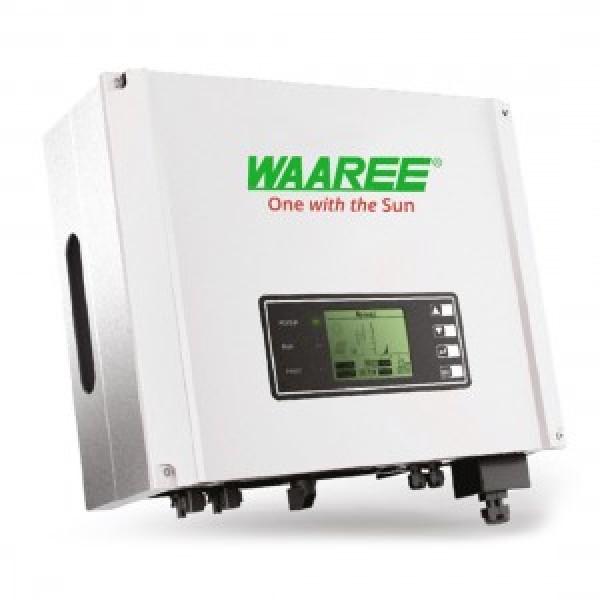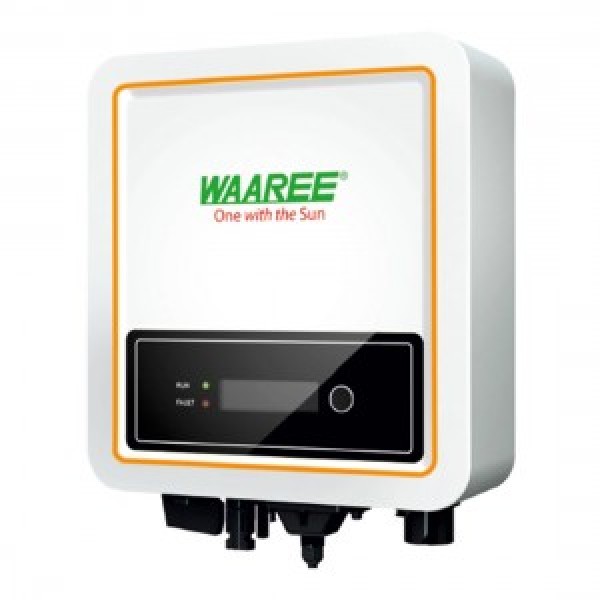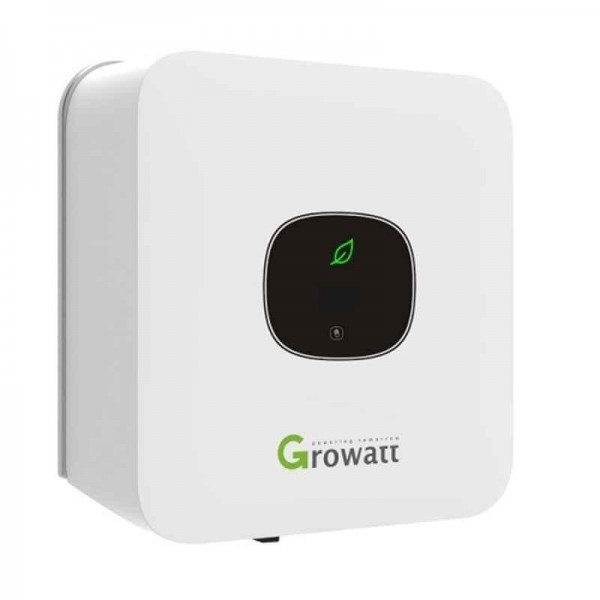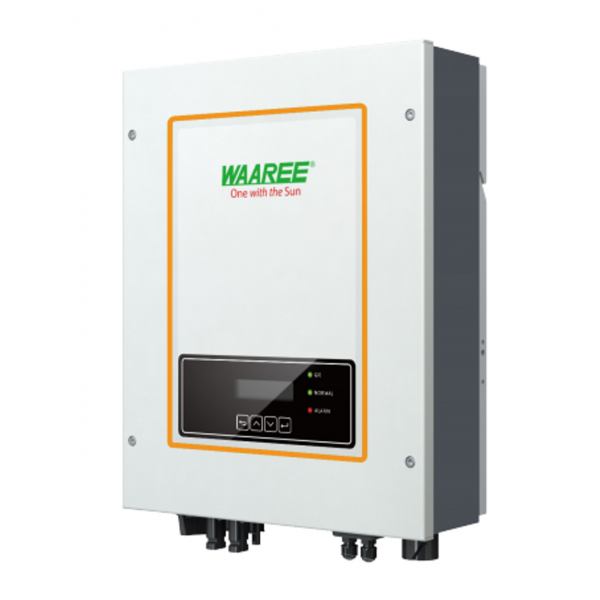Solar Grid-tie Inverter
A grid-tie solar inverter converts direct current (DC) into alternating current (AC) and helps consumers to utilize sufficient power, which is generated from solar energy and stored to the local electrical grid. A grid-tie inverter is also called on-grid solar inverter and suitable for inserting into an electrical power grid, usually 120 V RMS at 60 Hz or 240 V RMS at 50 Hz. The solar power inverter like grid-tie inverter in India uses between local electrical power generators such as solar panel, wind turbine, hydro-electric, and the grid. The grid-tie solar inverter is generally used to provide electricity supply in homes and offices without the need to depend on grid electricity.
Gone are those times when people hardly experience power cuts because grid-tie or on-grid solar inverter for home comes with great features to provide excellent power backup and without even depending on diesel generators or battery-powered inverter systems. You can save up to Rs. 8500 per year just by using the 1KW solar inverter system as compared to grid electricity. A grid-tie is one of the best solar inverters especially for home, used with customizable solutions to generate and provide power solutions based according to your requirements. SolarClue is the online platform to buy solar grid-tie inverter at a shoestring budget.
SolarClue’s inverters cater to various industries with its brand such as Power-one. People can check the solar inverter price list on this particular brand name which is available with a different grid-tie inverter price for the home.
Components Used in Grid-tie Inverter
A grid-tie inverter is manufactured using the following list of components.
• Battery Bank
• Power Meter
• Battery-Based Grid-Tie Inverter
• Charge Controller
• DC Disconnect (additional)
Advantages of Grid-Tie Solar Inverter
• Allows customers to save more money with solar panels through net metering, and lower equipment & installation costs
• Helps to spend electricity in real-time as a utility grid is a virtual battery
• Provides power backup facilities by using clean, renewable natural solar energy to generate electricity supply
•
Eliminating the battery avoids secondary contamination of the battery and increases the average time between failures of the system.
• Provides high-efficiency power when consumers need additional electricity
• Known as a reliable source of backup power
• Beneficial for easy installation as these do not require the batteries to operate
On-grid Solar Power System is the most popular power system used by a maximum number of people. Since the rapid advancements of technology in the field of solar energy has increased, people are using solar power system more and more. What is the on-grid solar power system? The on-grid solar system is a solar PV system, which is used to generate power when the utility power grid is available. The on-grid system is connected to the utility grid to send excess power generated back to the grid when you overproduce, and hence you credit it for later use.
The electricity produced by the on-grid system routes to the grid from where it is used by the consumers to run their various appliances. One of the foremost benefits of this system is to pay for itself by offsetting utility bills even in 3-8 years. Furthermore, the on-grid solar power system is the most cost-effective to purchase, fuss-free, useful to reduce carbon footprint, easy to install, and easy to maintain.
The on-grid solar power system is also known as a grid-tie solar system widely used by homes and businesses. This type of power system does not need any battery and uses common solar inverters by connecting to the public electricity grid. The on-grid solar panel system is unable to generate electricity during a blackout due to safety reasons. However, it only works when there is a constant electricity supply from the power grid.
SolarClue is one of the best platforms where people can purchase an on-grid solar system for different capacities such as 1kw, 2kws, 3kws, 5kws, and 10kws. The on-grid solar power system price varies from one brand to another available with SolarClue.
Components of on-grid solar power system
• Solar Panels
• Solar Inverter
• ACDB-DCDB
• Structure
• Wires
• Nut-Bolts
• Complete Accessories
Benefits of using on-grid solar power system
1. Zero Electricity Bills: The consumers do require to pay only for the surplus electricity they consume because the solar on-grid system is installed even on the rooftop and connected to the utility grid. However, the excess electricity feds back in the grid if the consumers utilize less electricity on any month.
2. Easy Maintenance and Simple Installation: Since the on-grid solar power system even in India is operated not to using any battery, which makes its maintenance quite easy. Further, it is operated using the least number of parts hence known for simple installation.
3. Passive Income Generation: The consumer can charge for the surplus electricity, which he or she generates because the on-grid power system generally connects to the grid. It provides cost benefits for the excess electricity generated and also eliminates your electricity bills.
Some other advantages of the on-grid solar power system are as follows:
• Fully utilizes the solar in priority and then remaining power take from the grid
• Uses as the most economically viable system where battery bank is not required
• Helps to lower your fuel consumption even to run the generator when the power goes off
• Reduces both the power and diesel consumption
How does on-grid solar power system work?
The arrangement of solar modules or on-grid solar power plant works in such a way to absorb the sunlight and convert it into electricity. The electricity generated here in the solar on-grid power system is Direct Current (DC). And the solar inverter then converts the DC to Alternating Current (AC), thus making it power the electrical items.
This electricity with the use of net meter is then routed to the grid and supplied for day to day use. The net meter is a device that records the energy supplied to the grid and the energy consumed. At the end of each month, the outstanding is recorded and provided to the consumer with a bill.
It is recommended to use the on-grid solar power system if you want to reduce your electricity bill and having a reliable grid where power cut happens in the day time and less than 2 hours.
The solar power system is a complete setup ideal for home and commercial places, which helps in producing electricity by utilizing solar energy (sunlight). A solar power system is made up of solar panel (which absorbs sunlight), inverter (which converts DC electricity into AC), mounting structure (which holds the panels in place), batteries (helps to store the extra power generated), grid box and balance of systems (wires, nuts).
In other words, a solar power system is composed of numerous photovoltaic (PV) panels, inverter (a Dc to AC power converter), and a rack system that holds the PV panels in place (solar PV panels on the roofs of homes and businesses generate clean electricity by converting the energy in sunlight). Solar power system comes in 1 kW, 3kW, 5kW, 10kW, and several other capacities. It is a good choice for those who want to reduce their electric bills and their carbon footprint.
As the prices of electricity are rising, people across the world looking for renewable energy sources for their power, or electricity needs. Solar energy has now become a popular renewable energy source because of its cost-effective price and improving efficacies. And for this reason, the solar system for home has stepped forward in the market with its great features.
On-Grid Solar System
The on-grid solar system or Grid-tied solar system is a kind of solar system that generates current only when the utility power grid is available. In other words, the on-grid system is a solar system that generally works with the grid. Saving the electricity bill is the prime purpose of installing an on-grid solar system.
The on-grid solar power system consists of Solar Photovoltaic modules / Panels, DC-AC grid-tied solar Inverter and Installation Kit (includes mounting structures, ACDB, DCDB, A.C, D.C wire, Connectors, lighting arrestor, earthling cables).
The foremost benefit of installing an on-grid solar system for home is a cost-effective solution, which helps to pay for such systems by offsetting utility bills in 3-8 yrs. In addition to this, there are some other advantages of the on-grid solar system, including:
• Zero electricity bills (consumer has to pay only for the surplus electricity he consumes because the solar power system is connected to the grid only).
• Easy maintenance (on-grid solar power system has the least number of parts along with simple installation or fitting).
• Passive income generation (with connection to the grid, the consumer can charge for the surplus electricity he has generated, which is not only beneficial in reducing your electricity bills but also helps to avail the cost benefits for the excess electricity generated).
• Provides you with at least 5 years' payback time and free electricity for the next 20 years.
Moreover, the on-grid solar system is simple enough that anyone can install it by himself. The on-grid solar system price is affordable that anyone can purchase it by investing at pocket-friendly prices.
Off-Grid Solar System
The off-grid solar system is a popular type of solar power system with backup, which works both day and night. During the day time, solar panel charges the battery to run the home appliances with the use of DC, and at night or cloudy weather days when the sunlight is not available, inverter runs your home appliances (Air Conditioners, Cooler, Television and submersible pump, etc.) using the battery power or AC current.
The off-grid solar system allows you to store your solar power in batteries for future use, especially when the power grid goes down or if you are not on the grid. Hybrid systems are capable of providing power to balance the grid power whenever the sun shines, which enable to send excess power to the grid for later use.
The utmost benefit of using an off-grid solar system is to provide power for your critical loads when the power grid becomes down. An off-grid system is more prevalent that comes with a power backup and works independently of the grid.
Benefits of using off-grid solar system:
• Works as a self-sustainable system that can work independently and not depending on the grid
• Helps in avoiding power outages, which may occur without any warning
• Helps in generating enough power that can be stored and used at night or when the power grid is down
• Reduces electricity costs (fossil fuels are still the world's primary energy source)
• Easier installation facilities
• Best alternative for remote areas where there is no power access from the grid
• Keeps the environment clean and green
Hybrid Solar System
The hybrid solar system is another type of solar power system that generates power or electricity supply in the same way as the common grid-tie solar system does. The only difference of a hybrid solar system is that such a system uses batteries to store energy for later usage. A hybrid solar system can operate as backup power, and it is possible because of the ability to use the maximum amount of stored energy (uses this energy during a blackout which is similar to a UPS system).
The term ‘hybrid solar system’ refers to a combination of battery storage and solar systems in which the off-grid system is connected to the electricity grid. Hybrid solar system is classified into three types such as All-in-one Hybrid Inverter (which contains a battery inverter/charger and solar inverter together with clever controls), All-in-one Inverter with no Back-up (works like a grid feed solar inverter which enables storage of solar energy in the battery system for the self-use), and All-in-one Inverter with Back-up (used as both an on-grid or off-grid inverter, which has a great backup capability).
Advantages of hybrid solar system:
• Allows consumers to store excess solar power or low cost (off-peak) electricity
• Allows using of solar energy during the evening times (known as self-use or load-shifting)
• Facilitates with backup power capability that helps to provide power during a blackout or grid outage like a UPS function
• Enables advanced management of electricity power and energy independence
• Reduces the power consumption from the grid
Solar Accessories
Solar accessories are important for all your small and large-scale power generation requirements. The main accessories used in solar power system installation are Batteries, Solar Charge Controllers, Off-Grid Solar Panels, and Solar Battery Enclosures.
Solar batteries: Solar batteries for home energy systems are made using lithium-ion batteries (lighter and more compact than lead-acid batteries) rather than lead-acid, and saltwater. Lead-acid batteries are used in off-grid energy systems that have a relatively short life, and lower DoD than other battery types. Saltwater batteries (newcomer in the home energy storage industry) don’t contain heavy metals as compared to other home energy storage options. Solar batteries are considered the best in terms of battery capacity & power ratings, depth of discharge (DoD), round-trip efficiency, warranty, and finest manufacturing facilities.
Solar charge controllers: Solar charge controllers are a voltage regulator to keep batteries from overcharging and also regulates the current coming from the solar panels going to the battery. A solar charge controller is categorized into two different technologies, PWM and MPPT. An MPPT charge controller is more expensive than a PWM charge controller but worth buying it even if expending more money.
Off-grid solar panels: This particular solar panel consists of a battery, charge controller, grid box, inverter, mounting structure, and balance of systems. Off-grid solar panels can store enough sunlight during the day, and use the excess power generated in the night.
Solar battery enclosures: Solar battery enclosures are used to keep your batteries safe from weather, and safe from theft. It is attributed with feature locking mechanisms that protect unauthorized people against possible electrical dangers if they happen to be tampering with your equipment. Battery enclosures for solar systems are pole-mounted or ground-mounted and suitable for indoor and outdoor applications.
Solar Inverter is an indispensable device used in any solar power system utilizing sunlight or solar energy. A solar inverter is useful in changing the DC (Direct Current) into AC (Alternating Current) using solar power. In other words, the solar inverter is used to change the variable Direct Current (DC) output of the solar products into Alternating Current (AC). And this AC power is pushed into your home to operate your appliances, be it a bulb, fan, or home system.
A solar inverter is just an inverter operated using energy from the sun, which helps several devices working by DC power to run them on AC power. In this way, the consumers can use AC power to operate their required piece of equipment. One can ask why to use Solar Inverter instead of using a normal electric one. The answer is simple - solar inverter makes use of solar energy or sunlight, which is clean and pollution-free.
Usage of DC current and AC current as per Application Areas
• Direct Current electricity from the solar inverter is used to operate LED light, a cell phone charger, Bluetooth speaker and many more small devices that require less power consumption.
• Alternating Current power from solar inverter is utilized for running your big appliances such as TV, refrigerator, and microwave, which require heavy power to run properly.
Advantages of Using Solar Inverter
• Helps in diminishing the impact of unnatural weather change as it works through sunlight
• Help in retaining ecological balance, and decreases the greenhouse effect
• Helps you to save money or electricity cost in the long run
• Known as a reliable and consistent source of energy that can change direct current (DC ) into alternating current (AC)
• Acts as multifunctional electronic device that uses to convert direct current into alternating current to help large energy consumers
• Beneficial for cost-efficiency, easy installation as compared to generators
• Easy to maintain as it works fine even with regular maintenance
Types of Solar Inverter
There are diverse arrays of Solar Inverters available in the market. Some of them are listed below.
1. Grid Tie Inverter or On-Grid Solar Inverter
Grid Tie Inverter or On-Grid Inverter is a type of solar inverter connected to the grid by using solar energy. It produces a pure sine wave that is compatible with the AC waveform produced by the grid. Grid Tie inverter is designed and developed in such a way to automatically turn itself off during the time of power losses to ensure safety or security. For this reason, this particular inverter is unable to provide emergency power during such times (when power not exists).
Grid Tie Inverter is also known as PV inverter that allows consumers to drive any unused or surplus solar energy, which your system has generated back into the grid. And consumers can or cannot receive a feed-in tariff for this electricity (depends on users’ electricity provider, and area of residence).
On-Grid Solar Inverter generally requires its arrangement to be installed with anti-islanding protection. Islanding is a kind of procedure where Grid Tie inverter are deceived and utility grid still functioning even if it has been turned off. It happens due to load circuits produces in the electrical system. When it comes to the cost of such a product, on-grid solar inverter price is varied from one brand to another, based on its capacity.
It is recommended to use Grid Tie solar inverter for home purposes, which can be powered by a utility grid to use a grid tie inverter in their solar system. Moreover this is highly beneficial for the consumers when it comes to electricity saving.
2. Hybrid Solar Inverter
Hybrid Solar Inverter performs the same function as a normal inverter does. It is another kind of inverter, which converts DC electricity into AC electricity that your home can use. It also can use in charging and discharging your solar battery bank.
A hybrid inverter with solar battery charging is a cost-effective solution and convenient to install as compared to other types of inverters (a standard string and battery inverter). The majority of hybrid inverters are installed without batteries, which provide you the flexibility to retrofit a solar battery in the future when required. Hybrid Inverter is known as a multi-mode inverter because it can use to plug batteries into your solar power system, and interfaces the battery by using a technique called DC coupling. People can purchase it as per their requirement as Hybrid Solar Inverter price is reasonable in India, irrespective of its size and volume.
3. Off-Grid Solar Inverter
Off-Grid Inverter is one of the categories of solar inverter, responsible for the conversion of DC (generates by the system’s panels) into AC electricity to use varied home appliances, and commercial equipment. Off-Grid Solar Inverter can transfer excess solar electricity into the grid for consumer’s future use. And, for this reason, Off-Grid inverter is used especially in remote areas, where the house owner can separate it from the grid as per his requirement.
The utmost benefit of using Off-Grid inverter solar system gives your home greater energy independence that means your home is no longer at risk to power disruption caused by the grid or electric tower. Off-Grid Solar Inverter comes with a built-in AC charger alternative, which is also beneficial for users by allowing them to connect it with a backup generator and charge any battery.
Explore SolarClue’s range of
solar products that are perfect for every application. So, whether you are
looking to buy solar energy-based products online, or you simply want to get a
solar power system delivered to your place, meet your requirements fulfilled by
shopping from Solarclue.com. Are you situated in Kalluvathukkal, Kerala, and
want a panel for your house, visit solarclue.com and place your order today.



